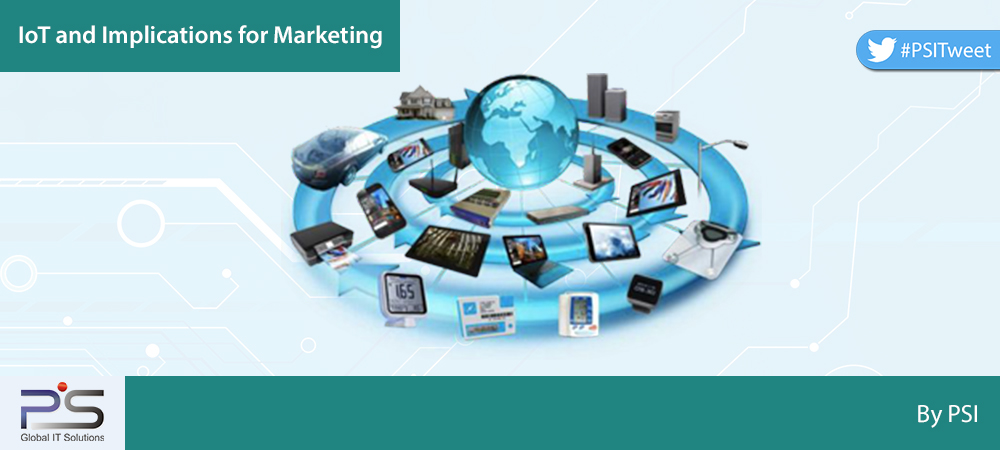
Today we can witness an upsurge of devices and information in the technology sphere. Internet of Things (IoT) implies innovative ways of internet connecting everyday objects and their inter-operative behaviour in our daily lives.
IoT is bound to influence government policies and regulations, privacy and technology provisions. Nevertheless, it will be interesting to understand its implications for the marketing domain. How can it enable and revolutionize the way we would view and perceive brands and messaging?
If marketing is unable to address customers’ expectations of convenience, the customers might even reject the product offerings. Marketing has to relate and deliver the highest form of convenience for the customers.
The major trends to be considered are:
- Need of smart customer data: The marketers are always on the lookout for the data to analyse and predict the customer behaviour. A large number of organisations purchase the external data to get insights into the data. The organisations which use IoT related data show higher revenue growth as compared to the others.
- Innovative ways of customer engagement: The connected devices present new opportunities for the marketers to gather and analyse customer data. This helps to relate with customers and create a bond with them. The marketers estimate that by the year 2020, there will be around 1 trillion IoT connected devices. This connectivity will generate more data, which can be utilised by the marketers for promotional campaigns and more customer focused goods and services.
- Social platforms act as a strong medium for sales and marketing: Around 75% of B2B organisational buying is influenced by the social media presence of the organisations.
- Interconnected B2B and B2C markets: The generic methods used by B2C organisations to promote and advertise the products are being explored and utilised by the B2B organisations also. They are increasingly using programmed techniques to not only generate leads, but also prioritize leads.
- Stringent security measures: The enormous data collected by the technology holds security and privacy breach challenges. The organisations need to be transparent in collection of customer data. With increasing incidents of cyber-attacks, both the marketers and customers are apprehensive about it.
The technology will serve the marketers to understand the underlying behavioural attributes of the customers and provide valuable insights. The customers can be targeted using specific methods through IoT. Not only it helps in generating demand, but also predict solutions to customer issues. The interconnected devices will respond and offer solutions to specific problems. The understanding of the latest trends will create opportunities for both for marketing and overall businesses.
Image Courtesy: www.arm.com
Today we can witness an upsurge of devices and information in the technology sphere. Internet of Things (IoT) implies innovative ways of internet connecting everyday objects and their inter-operative behaviour in our daily lives.
IoT is bound to influence government policies and regulations, privacy and technology provisions. Nevertheless, it will be interesting to understand its implications for the marketing domain. How can it enable and revolutionize the way we would view and perceive brands and messaging?
If marketing is unable to address customers’ expectations of convenience, the customers might even reject the product offerings. Marketing has to relate and deliver the highest form of convenience for the customers.
The major trends to be considered are:
- Need of smart customer data: The marketers are always on the lookout for the data to analyse and predict the customer behaviour. A large number of organisations purchase the external data to get insights into the data. The organisations which use IoT related data show higher revenue growth as compared to the others.
- Innovative ways of customer engagement: The connected devices present new opportunities for the marketers to gather and analyse customer data. This helps to relate with customers and create a bond with them. The marketers estimate that by the year 2020, there will be around 1 trillion IoT connected devices. This connectivity will generate more data, which can be utilised by the marketers for promotional campaigns and more customer focused goods and services.
- Social platforms act as a strong medium for sales and marketing: Around 75% of B2B organisational buying is influenced by the social media presence of the organisations.
- Interconnected B2B and B2C markets: The generic methods used by B2C organisations to promote and advertise the products are being explored and utilised by the B2B organisations also. They are increasingly using programmed techniques to not only generate leads, but also prioritize leads.
- Stringent security measures: The enormous data collected by the technology holds security and privacy breach challenges. The organisations need to be transparent in collection of customer data. With increasing incidents of cyber-attacks, both the marketers and customers are apprehensive about it.
The technology will serve the marketers to understand the underlying behavioural attributes of the customers and provide valuable insights. The customers can be targeted using specific methods through IoT. Not only it helps in generating demand, but also predict solutions to customer issues. The interconnected devices will respond and offer solutions to specific problems. The understanding of the latest trends will create opportunities for both for marketing and overall businesses.
Image Courtesy: www.arm.com[:]








